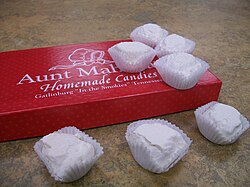
Summary
Divinity is a nougat-like confection made with whipped egg white, corn syrup, and sugar. Optional ingredients such as flavors, chopped dried fruit and chopped nuts are frequently added. Replacing the sugar with brown sugar results in a related confection called "sea foam".
 | |
| Type | Confection |
|---|---|
| Main ingredients | Egg whites, corn syrup, and sugar or brown sugar |
History edit
Believed to have originated in the U.S. during the early 1900s, the candy's current form can be traced to a recipe from 1915. An earlier version, which included the use of milk, can be traced to around 1907.[1]
One proposed theory for its origins is that in the early 20th century, corn syrup (a major ingredient) became commonly used as a popular sugar substitute. New recipes incorporating corn syrup were frequently created by the major manufacturers, one of which may have been divinity.[1]
The origins of the name are not clear. The most popular theory is simply that the first person to taste it called it "divine" and the name stuck.[1]
Divinity has at times been referred to as a "Southern candy", most likely because of the frequent use of pecans in the recipe. It eventually made its way north, and today its recipe can be found in many cookbooks.[1]
Weather and altitude edit
Humidity during preparation can affect the quality of divinity. For a batch to be successful, the humidity must be low enough for the candy to dry properly.
Due to the high amounts of sugar, divinity acts like a sponge. If the environment is very humid (over 50%) the candy will absorb moisture from the air, remaining gooey. This can be circumvented by heating the molten sugar to a higher temperature, typically up to around 270 degrees Fahrenheit.[citation needed] Under the right conditions, it is a soft, white candy which should be dry to the touch.
Divinity, like many other confections and baked goods, needs to have its recipe altered for high-altitude areas (over 3500 feet). One method is to reduce the temperature of the sugar mixture by about ten degrees Fahrenheit.
In popular culture edit
- In the Peanuts comic strip in the 1960s, Linus Van Pelt was shown to be fond of divinity, even being willing to compliment his sister Lucy Van Pelt to receive a piece.
- The B-52's song "Give Me Back My Man" features the line "Throws divinity on the sand", as the narrator's attempt to entice a hungry shark into sparing her sweetheart's life in exchange for the candy. This explanation is provided by Cindy Wilson in the book The B-52's Universe by Mats Sexton. The band, being from Athens, Georgia, would be familiar with this Southern candy.
- In the 1985 American romantic drama film Perfect, starring John Travolta and Jamie Lee Curtis, Curtis's character's mother talks about making the world's best divinity, offering some to Travolta.
- In the 2006 film Charlotte's Web, the town pastor offers the Arables divinities when they come to him about Charlotte's first "miraculous" web writing.
See also edit
References edit
- ^ a b c d Olver, Lynne. "Food Timeline FAQs: candy". The Food Timeline. Retrieved 2014-10-20.
... food historians generally agree that Divinity ... is an early 20th century American invention. ... One of the primary ingedients in early Divinity recipes is corn syrup, a product actively marketed to (& embraced by) American consumers as a sugar substitute at that time. Corn syrup was affordable (economical), practical (shelf-stable), and adapted well to most traditional recipes. Karo brand corn syrup, introduced by the Corn Products Refining Company in 1902, was/is perhaps the most famous. It is no coincidence that early Karo cooking brochures contain recipes for Divinity.


